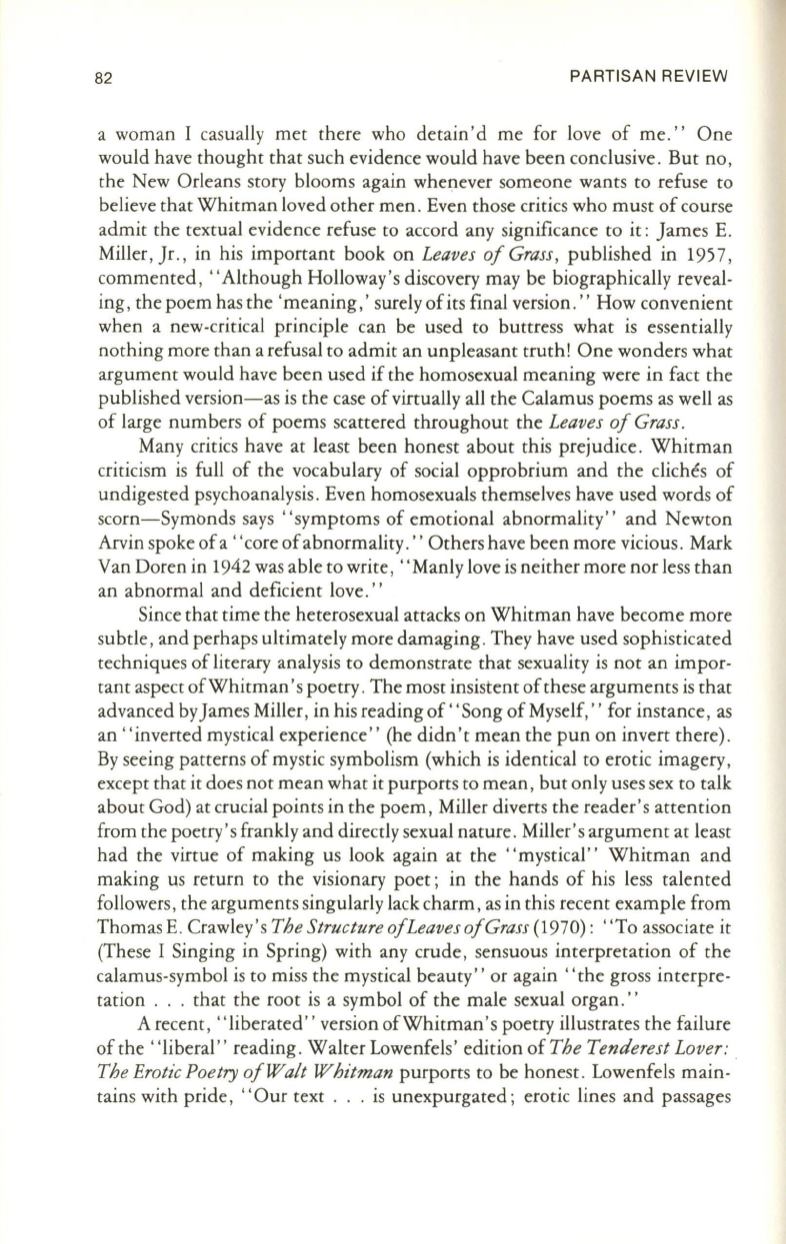
82
PARTISAN REVIEW
a woman I casually met there who detain' d me for love of me." One
would have thought that such evidence would have been conclusive . But no,
the New Orleans story blooms again whenever someone wants to refuse to
believe that Whitman loved other men . Even those critics who must of course
admit the textual evidence refuse to accord any significance to it: James E.
Miller,]r., in his important book on
Leaves a/Grass,
published in 1957,
commented, "Although Holloway's discovery may be biographically reveal–
ing, the poem has the'meaning,' surely of its final version. " How convenient
when a new-critical principle can be used to buttress what is essentially
nothing more than a refusal to admit an unpleasant truth! One wonders what
argument would have been used if the homosexual meaning were in fact the
published version-as is the case of virtually all the Calamus poems as well as
of large numbers of poems scattered throughout the
Leaves
0/
Grass.
Many critics have at least been honest about this prejudice. Whitman
criticism is full of the vocabulary of social opprobrium and the cliches of
undigested psychoanalysis. Even homosexuals themselves have used words of
scorn-Symonds says' 'symptoms of emotional abnormality" and Newton
Arvin spoke ofa "core ofabnormality .' , Others have been more vicious . Mark
Van Doren in 1942 was able to write , "Manly love is neither more nor less than
an abnormal and deficient love."
Since that time the heterosexual attacks on Whitman have become more
subtle, and perhaps ultimately more damaging . They have used sophisticated
techniques ofliterary analysis to demonstrate that sexuality is not an impor–
tant aspect ofWhitman 's poetry. The most insistent of these arguments is that
advanced by]ames Miller, in his reading of' 'Song of Myself, " for instance , as
an' 'inverted mystical experience" (he didn't mean the pun on invert there) .
By seeing patterns of mystic symbolism (which is identical to erotic imagery,
except that it does not mean what it purports to mean, but only uses sex to talk
about God) at crucial points in the poem, Miller diverts the reader's attention
from the poetry's frankly and directly sexual nature . Miller's argument at least
had the virtue of making us look again at the "mystical" Whitman and
making
uS
return to the visionary poet; in the hands of his less talented
followers, the arguments singularly lack charm, as in this recent example from
Thomas E. Crawley's
The Structure a/Leaves a/Grass
(1970): "To associate it
(These I Singing in Spring) with any crude, sensuous interpretation of the
calamus-symbol is to miss the mystical beauty" or again' 'the gross interpre–
tation ... that the root is a symbol of the male sexual organ ."
A recent, "liberated" version ofWhitman ,s poetry illustrates the failure
of the ' 'liberal" reading. Walter Lowenfels' edition of
The Tenderest Lover: .
The Erotic Poetry a/Walt Whitman
purports to be honest . Lowenfels main–
tains with pride, "Our text ... is unexpurgated; erotic lines and passages


